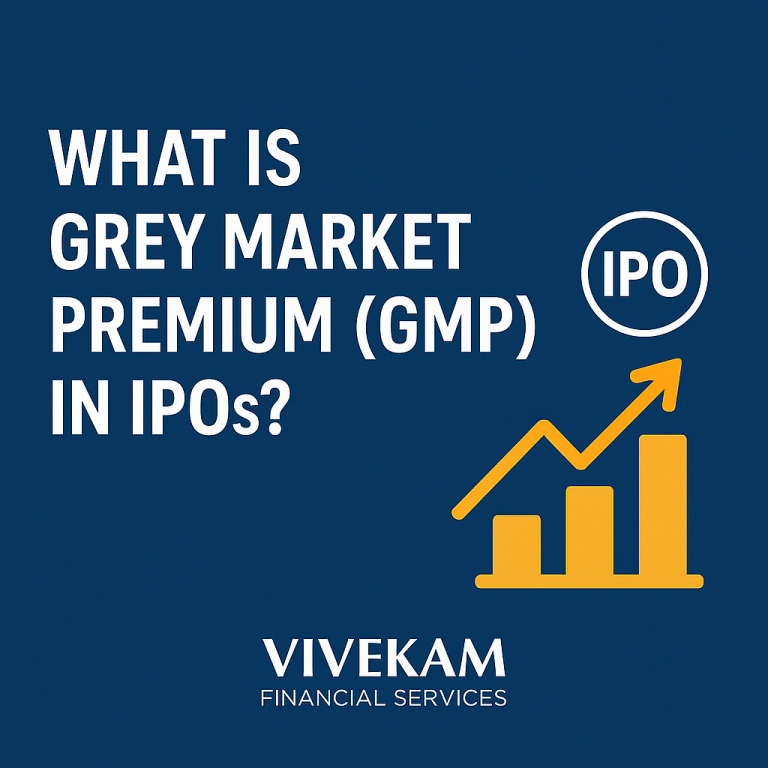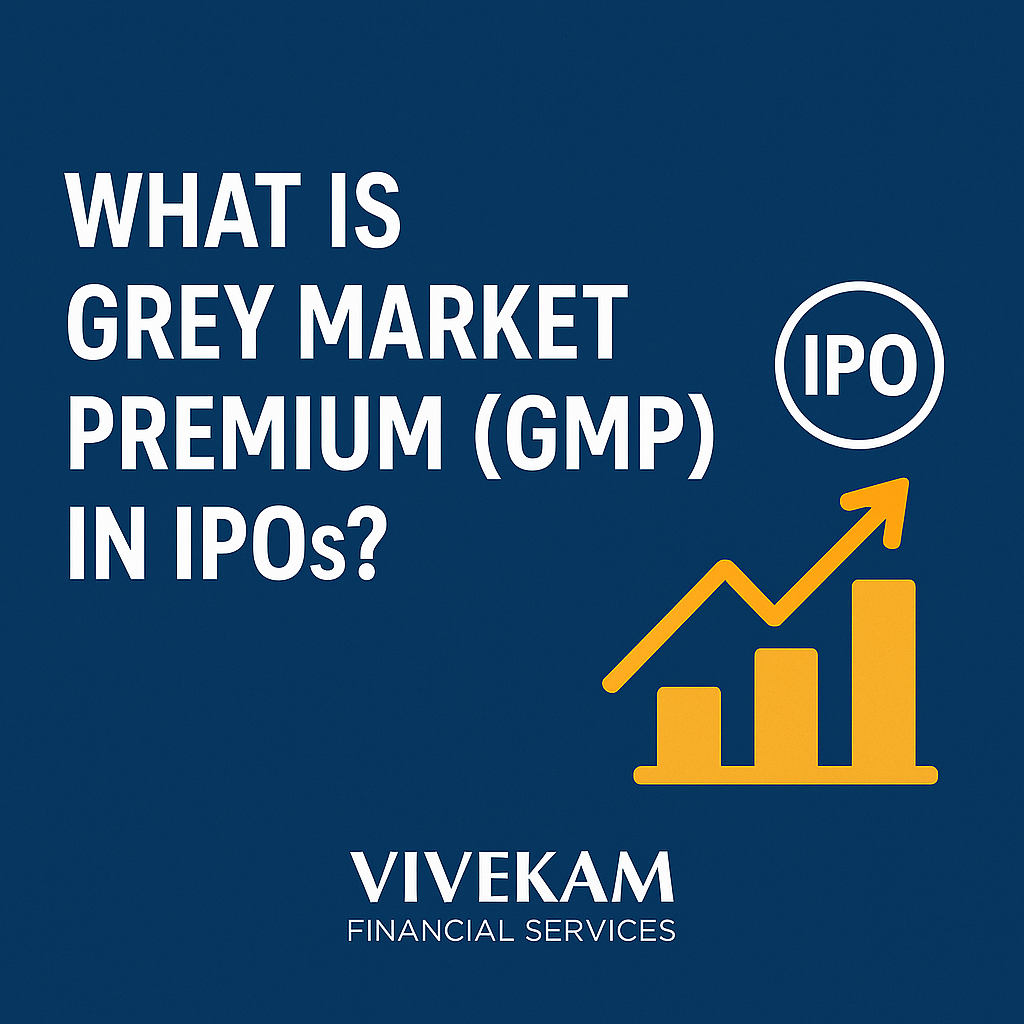What Is Grey Market Premium (GMP) in IPOs? Calculation, Meaning, and Impact on Listing Gains

Understanding Grey Market and Its Role in IPO Trading
The grey market in IPOs is the wild west of the investing world — unregulated, informal, and entirely driven by sentiment. It’s where shares of an IPO trade before official listing, giving investors a sneak peek into expected performance.
Unlike the stock exchange, this market runs on trust and word-of-mouth. Brokers act as the bridge between buyers and sellers, with no oversight from SEBI. Yet, despite being unofficial, the grey market plays a huge role in predicting how IPOs might perform on listing day.
What Are Grey Market Stocks?
Grey Market Stocks are shares of an IPO that change hands before being listed on exchanges like NSE or BSE. These stocks exist only in the shadows of the official market — they’re not recorded on any exchange, but they’re traded actively among brokers and high-demand investors.
Trading in these stocks gives investors an early advantage — but it also comes with zero protection if things go south.
Why Investors Trade in the Grey Market Before IPO Listing
The allure of the grey market lies in anticipation. Investors use it to:
- Estimate listing gains before the IPO hits the exchange.
- Lock profits early, especially in oversubscribed issues.
- Gauge real demand, beyond official subscription numbers.
However, with great risk comes great volatility — these trades depend on unverified information and trust.
Meaning of Grey Market Premium (GMP)
The Grey Market Premium (GMP) is the heartbeat of the IPO grey market. It’s the price difference between the grey market rate and the issue price.
In simple terms: GMP shows what investors expect the IPO to list at.
Example:
If an IPO’s issue price is ₹200 and its grey market price is ₹260, the GMP = ₹60.
This means the market expects a 30% premium on listing day.
How Grey Market Premium Reflects Market Sentiment
A soaring GMP means one thing — investors are bullish. It signals high demand and optimism around the company.
On the other hand, a flat or negative GMP indicates skepticism, suggesting potential listing losses.
Think of GMP as the IPO world’s “weather forecast” — it’s not always right, but it gives a good sense of the coming storm.
The Relationship Between GMP and Listing Gains
Historically, a strong GMP has often correlated with healthy listing-day gains, especially in hot IPOs.
However, factors like market conditions, FII inflows, and global sentiment can easily flip the script.
Pro Tip: Never chase an IPO purely because of its GMP — always check fundamentals, financial ratios, and business strength first.
GMP Calculation Explained
Now, let’s break down how the GMP of an IPO is calculated and what it truly signifies for investors.
Formula to Calculate Grey Market Premium in IPO
GMP = Grey Market Price – Issue Price
Expected Listing Price = Issue Price + GMP
Example:
If the issue price is ₹500 and the GMP is ₹75, then:
Expected Listing Price = ₹575
This implies a potential 15% listing gain, assuming market conditions remain stable.
Factors That Influence GMP Calculation
- Subscription Levels: Higher oversubscription → higher GMP.
- Company Reputation: Trusted brands attract higher premiums.
- Market Mood: A bullish market lifts all GMPs; a bearish phase pulls them down.
- Sector Demand: Hot sectors like fintech or renewable energy often see higher GMPs.
- Retail Hype: Heavy buzz on social media or investor forums can artificially inflate GMP.
Types of Trading in the Grey Market
Understanding types of trading in the grey market helps investors decode the entire ecosystem of unofficial deals.
1. Grey Market Trading
Direct buying and selling of IPO shares before official listing. Prices are decided through mutual agreement between investors, facilitated by dealers.
2. Kostak Rate
The Kostak Rate is the price an investor gets for selling their IPO application before allotment.
Example: If the Kostak Rate is ₹1,500, the buyer pays this amount to acquire rights to that application, regardless of allotment outcome.
3. Subject to Sauda (S2S) Deals
In S2S deals, payment happens only if shares are allotted.
If no shares are allotted, the deal is void. These trades are riskier but can yield big profits in oversubscribed IPOs.
How Does IPO Grey Market Work?
Here’s how the IPO grey market typically functions:
- IPO closes for subscription.
- Dealers start tracking investor interest.
- GMP is quoted based on demand.
- Buyers and sellers strike informal deals through brokers.
- Settlements happen in cash or through private arrangements.
Role of Dealers and Brokers in Grey Market
Brokers are the unseen hands running the grey market. They keep logs of transactions, maintain trust networks, and ensure deals close smoothly — albeit outside regulatory purview.
Example: Hypothetical Grey Market IPO Scenario
Let’s say the issue price of an IPO is ₹250. The grey market quotes a GMP of ₹50, predicting a listing at ₹300.
But due to negative market sentiment, it lists at ₹270 — still profitable, but not as much as expected.
Lesson: GMP hints at direction, not destination.
Impact of Grey Market Premium on Listing Gains
A positive GMP indicates optimism — strong demand, oversubscription, and possible listing gains.
A negative GMP warns of weak interest and potential listing losses.
However, always remember: the real listing price depends on market sentiment, not just speculation.
Risks and Challenges of GMP Trading
Lack of Regulation and Legal Concerns
The grey market is completely unregulated by SEBI or any authority. Investors have no legal protection, and disputes are handled informally.
Market Manipulation and Fake GMP Rates
Social media hype often creates artificial GMP spikes. Some platforms even publish inflated numbers to mislead retail investors. Always rely on credible portals like Chittorgarh.com or IPOWatch.in.
Advantages and Disadvantages of Relying on GMP
|
Pros (Why Investors Watch GMP) |
Cons (Why It’s Risky) |
|
Predicts IPO sentiment |
Unofficial & unregulated |
|
Helps estimate listing price |
Prone to manipulation |
|
Quick insight into market mood |
Doesn’t guarantee profit |
Expert Tips for IPO Investors

- Use GMP as a compass, not a map.
- Analyze company fundamentals before applying.
- Cross-check GMP trends with subscription data.
- Don’t fall for “fake GMP” Telegram groups or influencers.
Frequently Asked Questions (FAQs)
Q1. What is the GMP of IPO?
It’s the price difference between the grey market rate and the IPO’s issue price, reflecting expected listing gains.
Q2. Is trading in the grey market legal?
No. It’s unofficial and not regulated by SEBI.
Q3. Does a high GMP guarantee profits?
Not always. GMP predicts sentiment, not certainty.
Q4. How do I calculate GMP?
Use: GMP = Grey Market Price – Issue Price.
Q5. What is the difference between Kostak Rate and Subject to Sauda?
Kostak = premium on an application.
Subject to Sauda = deal only valid if shares are allotted.
Q6. Where can I check authentic GMP data?
Refer to trusted sites like Chittorgarh.com or IPOWatch.in for verified updates.
Conclusion: Should You Trust Grey Market Premium Before Investing in IPOs?
The Grey Market Premium (GMP) in IPOs is a useful pulse check — it reveals how the street feels about an upcoming listing. But it’s no crystal ball.
Treat GMP as one of many indicators, not your investment gospel. Combine it with sound research, company fundamentals, and long-term perspective to make smarter IPO decisions.







